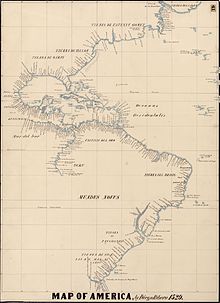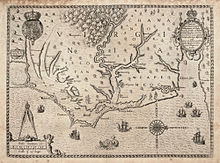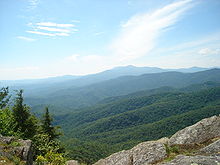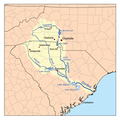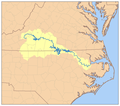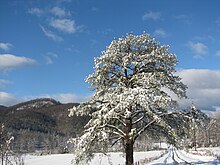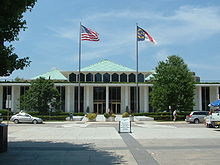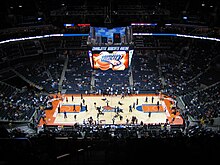North Carolina
North Carolina (in English, North Carolina; AFI pronunciation: / ˈnɔɹθ ˌkæɹəˈlaɪ̯nə/) is one of the fifty states that, together with Washington D.C., make up the United States of America. Its capital is Raleigh and its most populous city, Charlotte.
It is located in the southern region of the country, South Atlantic division, bordered by Virginia to the north, the Atlantic Ocean to the east, South Carolina to the south, Georgia to the southwest, and Tennessee to the west. With 9,535,483 inhabitants. in 2010 it is the tenth most populous state, behind California, Texas, New York, Florida, Illinois, Pennsylvania, Ohio, Michigan and Georgia. It was admitted to the Union on November 21, 1789, as the 12th state.
It was home to the first British colony in the Americas and one of the secessionist Thirteen British Colonies. The name of the state was chosen by King Charles II of England, in honor of his father, King Charles I. North Carolina has three metropolitan areas with populations of more than one million. According to the 2010 United States Census, its population was 9,535,483 inhabitants, 18.46% more than in the 2000 Census. It is the third most populous state in the southeast of the country, behind Florida and Georgia. North Carolina is the 28th largest in the United States and the 10th most populous of the 50 United States.
Due to its range of elevations, from sea level on the coast to 2,000 meters in the mountains, North Carolina has one of the most varied climates of the southeastern states. The climate in coastal and central North Carolina is similar to that of Georgia and South Carolina, while in the western mountains it is similar to that of New England. Thus, the climate of the state varies from a warm and humid subtropical climate near the coast, to a humid continental climate in the mountains.
History
Amerindian peoples
In its beginnings North Carolina was inhabited by different native peoples, among which were the Cherokee, Tuscarora, Cheraw, Pamlico, Meherrin, Coree, Machapunga, Cape Fear, Xaxhaw, Saponi, Tutelo, Waccamaw, Coharie and catawba.
Discovery and exploration
In 1523, Lucas Vázquez de Ayllón, and with the authorization of Emperor Carlos I of Spain, organized an expedition to search for the northern passage to the Spice Islands, exploring the east coast of the current United States (states of Virginia and Carolina from North). In 1526, Vázquez de Ayllón was the first European to explore and map the Chesapeake Bay. He established a small town which he called "San Miguel de Guadalupe"; The location of that town is disputed, and some authors place it in what was later the city of Jamestown (Virginia), and others at the mouth of the Pee Dee River.
In 1567, Captain Juan Pardo led an inland expedition to claim the area for the Spanish colony of Florida, as well as create another route to protect the silver mines in Mexico. Pardo made a winter base in Joara, which he renamed Cuenca. The expedition built Fort San Juan and left 30 men in it, while Pardo traveled further and built and left personnel in five other forts. He returned by a different route to Saint Helena in Parris Island, South Carolina, then to central Spanish Florida. In the spring of 1568, the Indians killed all the soldiers and burned the six forts built inside, including Fort San Juan. Although the Spanish never returned to the interior, this was the first European attempt to colonize the interior of what would later become the United States. A 16th-century diary of Pardo written by his assistant Bandera and other archaeological finds found since 1986 in Joara have confirmed this.
In 1584, Queen Elizabeth I of England granted a charter to Sir Walter Raleigh naming the current capital of the state of North Carolina (then Virginia) Raleigh. Raleigh established two colonies on the coast in the late 1580s, but both would end in failure, including the Roanoke Colony. That was the second territory that the British tried to colonize on the continent. Virginia Dare was the first person of English parents born in America, and her birth was in North Carolina. What happened to her and the other Roanoke settlers is a mystery.
Colonial Period
North Carolina's first permanent European settlers were British settlers who migrated to southern Virginia after the colony's rapid growth and subsequent scarcity of available farmland. Nathaniel Batts was documented as one of the first of these emigrant Virginians. They settled south of the Chowan River and east of the Great Dismal Swamp in 1655. In 1663, this northeastern part of Carolina Province, known as the Albemarle Settlements, was suffering from British settlement. During the same period, King Charles II of England gave the province to a group of nobles who had helped restore him as king in 1660. The new province of Carolina was named in honor and memory of King Charles I of England. In 1710, due to discussions of the Governorate, the Carolina Colony was divided into North Carolina and South Carolina. In 1729, North Carolina became an independent colony, with the exception of the holdings of John Carteret, 2nd Earl Granville, which became a royal colony seventeen years later. Differences in the settlement patterns of the eastern and western North Carolina affected the political, economic, and social life of the state from the 18th century to the 18th century. XX. The east of the state was largely settled by immigrants from England and the Highlands of Scotland. The west was largely settled by the Scots, Irish and Protestants from Germany.
Independence
On April 12, 1776, the colony became the first to have its delegates to the Continental Congress vote for independence from the British crown. The dates of both events that are related to independence are commemorated on the state flag and the state seal. Throughout the Revolutionary War, fierce guerrilla warfare broke out between pro-independence gangs and others who were pro-British colonies. In some cases, the war was also an excuse to settle private affairs, grudges, and rivalries. A major American victory in the war took place at the King's Pinnacle, along the North Carolina/South Carolina border. The American victory at Kings Mountain gave the pro-independence colonists a better chance of achieving their objective by preventing the British Army from recruiting new soldiers.
As the British Army moved north following victories at Charleston and Camden, South Carolina, the Continental Army of the South and local militias prepared to meet it. Following General Daniel Morgan's victory at the Battle of Cowpens on January 17, 1781 over British cavalry commander Banastre Tarleton, Southern commander Nathanael Greene led Lord Charles Cornwallis through central North Carolina away from its base. This campaign is known as "The race to the Dan" or "The race to the river".
Generals Greene and Cornwallis finally met at the Battle of Guilford Courthouse, in present-day Greensboro, on March 15, 1781, where British casualties exceeded those suffered by the Americans. Following this "Pyrrhic victory," Cornwallis opted to move to the Virginia coast for reinforcements and to allow the British Royal Navy to protect the army from him. This decision would lead to Cornwallis' final defeat at Yorktown, Virginia, in 1781. The Patriots' victory guaranteed American independence.
On November 21, 1789, North Carolina became the twelfth state to pass the Constitution. Unlike many other states in the South, North Carolina never developed a dominant slave-owning aristocracy, and the middle class tended to control the government. Most of the plantations were located in the eastern part of Tidewater. To the west there used to be not many subsistence farmers. In the middle of the 19th century, the rural and commercial areas were connected by the construction of a 208 km road.
Antebellum period
On October 25, 1836, construction began on the Raleigh-Wilmington Railroad, to connect the port city of Wilmington with the state capital, Raleigh. In 1849 the North Carolina Railroad was built, in order to extend the railroad to also pass through Greensboro, High Point, and Charlotte. During the Civil War the Raleigh-Wilmington Railroad would be vital for the distribution of supplies shipped from Wilmington, through Raleigh, to Richmond, Virginia.
During the antebellum period, North Carolina was an entirely rural state. In 1860 only one city, the port city of Wilmington, had a population of more than 10,000. In Raleigh, the state capital, there were just over 5,000 residents.
Although slavery represented a smaller percentage of the population in North Carolina than in some southern states, according to the 1860 census, 33% of the population (of 992,622 people) were African-American slaves. Slaves lived and worked on plantations, mainly in the eastern Tidewater area. In addition, 30,463 free blacks lived in the state, mostly concentrated in the eastern coastal plain, especially around ports such as Wilmington and New Bern. Free African Americans were not allowed to vote until 1835.
Civil War
In 1860, North Carolina was a slave state, with a slave population comprising about one-third of the population, a smaller proportion than many states in the South. The state refused to join the Confederate States of America until President Abraham Lincoln insisted that it invade his "brother's" state, South Carolina. The state was the site of few battles, but it provided 125,000 soldiers to the Confederate States of America, far more than any other state. About 40,000 of those troops never returned to their homes, some died of disease, wounds sustained on the battlefield, and privation. Elected in 1862, Governor Zebulon Baird Vance tried to maintain state autonomy against the President of the Confederate States of America Jefferson Davis in Richmond, Virginia.
Even after secession, some people in North Carolina refused to support the Confederate States. This occurred primarily in the case of those who did not own agricultural slaves in the western mountains of the state and the Piedmont region. Some of these farmers remained neutral during the war, while some covertly supported La Unión during the conflict. Even so, Confederate States of America troops from all parts of North Carolina served in virtually every major battle for the Army of Northern Virginia. The largest battle in North Carolina was at Bentonville, a futile attempt by Confederate General Joseph Johnston to stop the advance of Union General William Tecumseh Sherman, in the spring of 1865. In April 1865 Johnston surrendered at Sherman Bennett Place, in what is now Durham. This was the last major army to surrender.
The first Confederate soldier to die in the war was Henry Wyatt, killed at the Battle of Big Bethel in June 1861.
With the defeat of the Confederacy in 1865, the Reconstruction Era began. The United States abolished slavery without indemnifying slaveholders or redressing freedmen. A Republican Party coalition of black freedmen, northern backpackers and local thieves controlled the state government for three years. White conservative Democrats regained control of the state legislature in 1870, in part through Ku Klux Klan violence and terrorism at the polls, to suppress the black vote. Republicans were elected to the governorship until 1876, when the Red Shirts, a paramilitary organization that emerged in 1874 and allied with the Democratic Party, helped suppress the black vote. More than 150 black Americans were killed in election violence in 1876. Post-civil war and debt cycles pushed people to switch from subsistence farming to mercantile farming. Between these times, the notorious Crop-Lien system developed and was financially difficult for landless blacks and whites, due to high amounts of usury. Also due to the boost of commodity farming, free range is over. Before this time, people fenced off their crops and had their cattle feed in the corral areas. After the end of the field, people now fenced in their animals and had their crops out in the open.
Democrats were elected to the legislature and the governor's office, but populists drew disgruntled voters with them. In 1896, a biracial, populist, and Republican fusionist coalition won the governor's office and passed laws that would extend franchise voting to blacks and poor whites. Democrats regained control of the legislature in 1896 and passed laws to enforce Jim Crow and the racial segregation of public facilities. Voters in North Carolina's 2nd congressional district elected a total of four African-American congressmen during these years in the late 19th century. Political tensions rose so high that a small group of white Democrats in 1898 planned to take over the Wilmington government if their candidates were not elected. In the Wilmington insurrection of 1898, more than 1,500 white men attacked the black newspaper and the neighborhood, killing numerous men and driving away the mayor and his white Republican aldermen. They installed their own people and elected Alfred M. Waddell as mayor, in the only coup in US history.
Physical geography
North Carolina is bordered by Tennessee to the west, South Carolina to the south, Georgia to the southwest, Virginia to the north, and the Atlantic Ocean to the east. North Carolina consists of three major geographic areas: the Coastal Plain, which occupies 45% of the eastern portion, the Piedmont region, which occupies 35%, and the Appalachians and Foothills. The eastern tip of the state contains the Outer Banks, a chain of narrow sand islands that form a barrier between the Atlantic Ocean and inland waterways. The Outer Banks form two straits: Albemarle Strait in the north and Pamlico Strait in the south. They are the two largest landlocked straits in the United States. The coastal plain is relatively uneven, with rich soils ideal for growing tobacco, soybeans, melons, and cotton. The North Carolina Coastal Plain is mostly rural, with few or no large cities. Agriculture is an important economic sector. The main rivers in this area, the Neuse, the Tar, the Pamlico and the Cape Fear, tend to be slow and wide.
The central Piedmont region is the most dense and urbanized in the area, with the five largest cities in the state being in the Piedmont. It is made up of gentle undulations, frequently interrupted by hills or low mountains. A number of small, isolated, and deeply eroded mountain ranges and peaks are found in the Piedmont. The Piedmont is between 90 and 120 m elevation in the east and over 300 m in the west. Due to Piedmont's rapidly growing population, many of the farms and much of the rural landscape in this region is being replaced by suburbanization - strip malls, housing developments and large company office areas. Agriculture is steadily losing importance in this region. The Piedmont's major rivers, such as the Yadkin and Catawba, tend to be fast, shallow, and narrow.
The western region of the state is part of the Appalachian Mountains. The Black Mountains are the highest in the eastern United States, culminating in Mount Mitchell at over 7,000 feet (2,037 m). It is also the highest point east of the Mississippi River. Although agriculture is still important, tourism has become the dominant industry in the highland area. An agricultural production that has prospered and grown in recent decades is the increasing sale of Christmas trees. Due to the higher elevation on the mountain, the climate often differs radically from the rest of the state. In winter, in western North Carolina, it is typical to see snowfall and temperatures more akin to a south-central state.
North Carolina has 17 major river basins. Five of the state's watersheds - the Hiwassee, Little Tennessee, French Broad, Watauga and New River basins - are part of the Mississippi River basin, which drains into the Gulf of Mexico. All the others go to the current of the Atlantic ocean. Of the 17 basins, 11 originate in the state of North Carolina, but only four lie wholly within the state's borders – Cape Fear, Neuse, White Oak, and Tar-Pamlico.
Maps
Climate
The coastal plain is under the influence of the Atlantic Ocean, which maintains mild temperatures in winter and moderate temperatures in summer. In summer, the maximum temperature on the coast averages less than 32 °C. In winter, the coast enjoys some of the mildest temperatures in the state, with daytime temperatures rarely falling below 5°C. On the coast it snows about three days a year, having years without the presence of snow.
The Piedmont region has less influence from the Atlantic Ocean, and as a result, its summers are hotter and its winters are colder than those along the coast. In the Piedmont, the daytime high temperature in summer typically averages 32°C. While it's not common for North Carolina to get temperatures above 37°C, when it does, the highest temperatures are in the lower Piedmont areas, especially around the city of Fayetteville.
In winter, the Piedmont climate is much less mild than the coast, with daily temperatures that can not reach -3 ° C, and the annual average snow level is 20 to 25 centimeters. Sleet rain and frost are notorious in the Piedmont, reaching several inches in height during some storms that hinder vehicle traffic and collapse electrical grids. The annual precipitation and humidity in the Piedmont region is less than that of the mountains or the coast, but even if it is less, the precipitation is about 100 liters per year. The coldest region of the state is in Appalachia, with daily winter temperatures dropping below -10°C or below and relatively cool summers rarely exceeding 25°C. Usually, the accumulated snow level in a year in the mountains is 35 to 50 centimeters, but it can be much higher in the high mountains.
Rough weather in North Carolina is not a rare event. On average, once a decade the state is hit directly by a hurricane, although some years several hurricanes or tropical storms may directly strike the state or sweep across coastal areas. Only Florida and Louisiana are hit by hurricanes more frequently. On average, North Carolina experiences 50 days of stormy activity per year, with some of the storms severe enough to produce hail and strong, damaging winds. North Carolina averages fewer than 20 tornadoes a year, many of them spawned by hurricanes or tropical storms along the coast. Without detriment, tornado storms are a risk, especially in the central region of Carolina: Piedmont.
Major cities
Charlotte is the most populous city in North Carolina. It has an estimated population of 695,995 inhabitants, amounting to 2,491,650 in its metropolitan area. Some of the most important cities in the state are:
|
|
Administration and politics
State executive power is exercised by the Lieutenant Governor and eight heads of elected executive departments form the State Council. Ten other heads of executive departments appointed by the Governor of North Carolina form the Cabinet. The current governor of the state, Roy Cooper, belongs to the Democratic Party. The North Carolina General Assembly, or Legislature, is made up of two houses: the 50-member Senate and the 120-member House of Representatives.
The North Carolina Supreme Court is the state's highest court of appeals; It is made up of a total of seven judges. The Court of Appeals is the only intermediate court in the state and is made up of fifteen judges. Together, the Supreme Court and the Court of Appeals constitute the appellate division of the judicial system. All criminal, civil, cases involving more than US$10,000, and misdemeanors are tried in the Supreme Court. A 12-person jury hears the cases. Civil cases—such as divorce, child custody, and cases under $10,000—are tried in the District Court, where criminal matters involving misdemeanors and misdemeanors are also tried. The trial of a criminal case in the District Court is always without a jury. The District Court also tries juvenile cases involving children under the age of 16 who are delinquent and children under the age of 18 who are unruly, dependent, neglected, or abused. Magistrates accept misdemeanor guilty pleas, guilty pleas, traffic violations, and accept value judgment waivers - to prove cases, among other things. In civil cases, the judge is authorized to hear claims of up to US$4,000, including landlord eviction cases. Magistrates also perform civil marriage.
State Constitution
The state constitution regulates the structure and function of the North Carolina government. Like all state constitutions in the United States, this constitution is subject to federal judicial review. Any of the provisions of the state constitution can be overturned if it conflicts with federal law and the Constitution of the United States of America.
North Carolina has had three constitutions:
- 1776: Ratified on 18 December 1776 as the first constitution of the independent state. The Bill of Rights was ratified the previous day.
- 1868: Framed according to the Reconstruction Acts after North Carolina was admitted again to the Union. It was an important reorganization and modification of the original in fourteen articles.
- 1971: Minor consolidation of the Constitution of 1868 and subsequent amendments.
Delimitation of federal districts
North Carolina currently has 13 congressional districts, so when combined with its two Senate seats, the state yields 15 electoral votes. In the 109th Congress, the state was represented by six Democratic and seven Republican members of congress, plus two Republican senators.
Politics
North Carolina is politically dominated by Democrats and Republicans. The specific weight of a third party has been very poor in the state; among the parties that have attempted to break into the state's political landscape are the Green Party and the Libertarian Party. The Libertarian Party is currently involved in a lawsuit with the state for access to the ballot. Historically, North Carolina has been politically divided between the eastern and western parts of the state. Before the Civil War, the eastern half of North Carolina supported the Democratic Party, especially since the region was home to most of the slaveholders and large cash crops. The western half of the state tended to support the Whig Party, which was generally seen as more moderate on the slavery issue and more pro-business. After the Civil War, the Republicans, supported by the victorious United States Army, controlled the state government. When federal troops were withdrawn in the 1870s, the Democratic Party quickly gained control of the government.
In 1894, the Republican and Populist parties formed an alliance, called an electoral coalition, that focused on control of the state legislature and government. However, in 1898 the Democratic Party, in a racist campaign, regained control of the state government. Under the motto, "White supremacism" and the endorsement of influential newspapers such as The News & Observer posted by Josephus Daniels, the Democrats overthrew the Populist-Republican party. With a few notable exceptions, North Carolina became a part of the "Solid Democratic South". However, some counties west of the Piedmont and Appalachian Mountains continued to support the Republicans, following a tradition dating from their opposition to secession before the Civil War. In 1952, aided by the presidential candidacy of noted war hero Dwight D. Eisenhower, the Republicans succeeded in electing a United States congressman, Charles R. Jonas. The Republicans made slow progress in the 1960s, and in 1972, helped by the re-election of Richard Nixon, the Republicans elected their first Governor and Senator of the Century XX.
From 1968-2004 (with the exception of Jimmy Carter's election in 1976), North Carolina has voted Republican in every presidential election. At the state level, however, Democrats still control most elective offices in state government, and state elections and local elections are highly competitive compared to previous historical eras. Republicans hold seats in the Senate, but Democrats retain the governorship, a majority in both houses of the state legislature and the state supreme court. The main cities of the state, especially Raleigh and Charlotte tend to vote Democratic, while in small cities and rural areas the Republican vote is very clearly imposed.
Two United States presidents have been born and raised in North Carolina, James K. Polk and Andrew Johnson, but both men began their political careers in neighboring Tennessee. A third President of the United States, Andrew Jackson, may also have been born in North Carolina; however, as he was born almost exactly on the South Carolina border, both states claim it as their own and historians have debated for decades the exact site of Jackson's birthplace. Jackson stated that he was born in what would later become South Carolina, but at the time of his birth the dividing line between the states was not yet determined.
North Carolina remains an alcoholic beverage control state. Four of the state's counties - Clay, Graham, Mitchell and Yancey, which are in rural areas - remain "dry" (The sale of alcoholic beverages is illegal.) However, the remaining 96 counties in North Carolina allow the sale and consumption of alcoholic beverages, as is the case in most of the United States. Even in rural areas, opposition to the sale of alcoholic beverages is waning, as the number of 'dry' counties is declining.
North Carolina is one of 12 states that have decriminalized marijuana. In 1997, marijuana and Tetrahydrocannabinol were moved from Schedule I to Schedule IV. Transfer of less than 5 grams is not considered a sale, and up to 42.525 grams is a misdemeanor punishable by a fine or community service, at the judge's discretion, instead of imprisonment or a felony.
In 2005, following major political maneuvering, the state Legislature voted to implement a state lottery, thereby changing North Carolina's reputation as the "anti-lottery," possession of a lottery ticket from another state was a crime. The North Carolina Education Lottery opened its doors on March 31, 2006. The lottery has had unexpectedly low sales since its inception.
Administrative division
North Carolina is divided into 100 counties. These counties are governed by Councils of Commissioners, made up of between three and seven members. All Commissioners are elected by the population of the county and remain in power for two to four years. These Commissioners have legislative and executive authority over the county. North Carolina has about 500 cities and towns. Each city or town has a popularly elected mayor.
Demographics
| Historical population | ||
|---|---|---|
| Year | Pob. | ±% |
| 1790 | 393 751 | - |
| 1800 | 478 103 | +21.4% |
| 1810 | 556 526 | +16.4% |
| 1820 | 638 829 | +14.8% |
| 1830 | 737 987 | +15.5% |
| 1840 | 753 419 | +2.1% |
| 1850 | 869 039 | +15.3% |
| 1860 | 992 622 | +14.2% |
| 1870 | 1 071 361 | +7.9% |
| 1880 | 1 399 750 | +30.7% |
| 1890 | 1 617 949 | +15.6% |
| 1900 | 1 893 810 | +17.1% |
| 1910 | 2 206 287 | +16.5% |
| 1920 | 2 559 123 | +16.0% |
| 1930 | 3 170 276 | +23.9% |
| 1940 | 3 571 623 | +12.7% |
| 1950 | 4 061 929 | +13.7% |
| 1960 | 4 556 155 | +12.2% |
| 1970 | 5 082 059 | +11.5% |
| 1980 | 5 881 766 | +15.7% |
| 1990 | 628 637 | +12.7% |
| 2000 | 8 049 313 | +21.4% |
| 2010 | 9 535 471 | +18.5% |
| 2012 (est) | 9 752 073 | +2.3% |
North Carolina is divided into 3 metropolitan areas, each with approximately 1 million residents:
- Metrolina: Charlotte-Gastonia-Salisbury, CN-CS Population: 2,191,604
- The Triangle: Raleigh-Durham-Chapel Hill, CN Population: 1,565.223
- Piedmont Triad: Greensboro-Winston-Salem-High Point, CN Population: 1,513.576
In 2006, North Carolina had an estimated population of 8,856,505 people, which represents a population increase of 2.1%, equivalent to 184,046 people, from the previous year and an increase 10.0%, 810,014 people, as of the 2000 census. This exceeds the rate of growth in the United States. The growth is made up of a natural increase since the last census of 293,761 people (749,959 births, minus 456,198 deaths) and an increase due to net migration of 527,991 people in the state. Immigration from outside the United States resulted in a net increase of 180,986 people. Migration from within the country produced an increase of 347,005 people. Between 2005 and 2006, North Carolina became the 10th most populous state in the United States.
North Carolina has historically been a rural state, with the majority of the population living in the country and in small cities. However, over the past 30 years North Carolina has experienced rapid urbanization. Today North Carolina residents live primarily in urban and suburban areas, as is the case in most of the United States. In particular, the cities of Charlotte and Raleigh have become large urban centers and rapidly growing populations. Most of this growth has been driven by immigrants from Latin America, India, and Southeast Asia.
Statistics
- 6.7 % of the population are under 5 years of age.
- 24.4% are under 18.
- 12.0 % is 65 years or older.
As of the 2010 U.S. Census, the racial makeup of North Carolina was: White: 68.5% (65.3% Non-Hispanic White, 3.2% White Hispanic), Black or African American: 21.5%, Latino/Hispanic of any race: 8.4%, some other race: 4.3%, multiracial American: 2.2%, Asian American: 2.2%, and Native Hawaiian/Islander Pacific: 1%
The Latino/Hispanic population is the fastest growing due to the high fertility rate of Latina women residing in the United States, and also due to legal and illegal immigration from Latin America and the Caribbean.
Religion
| Religion in North Carolina (2019) |
|---|
| Protestantism (67%) Irreligion (20%) Catolicism (9%) Orthodox Christians (1%) Other religions (3%) |
North Carolina, like other states in the South, has traditionally been Protestant. However, the rapid arrival of northerners and immigrants from Latin America continues to increase the number of Catholics and Jews in the state, and the numerical dominance of the Baptist Church is beginning to decline. This is especially evident in the urban areas of the state, where the culture is more diverse. However, in many rural counties the Baptist Church remains the dominant Christian church. The second largest Protestant church in North Carolina is the Methodists, which has a large following in the northern Piedmont and especially in the towns of Guilford County. There are also significant numbers of Quakers in Guilford County and northeastern North Carolina. Presbyterians have historically had a strong presence in Charlotte, the largest city in the state, and in Scotland County. Religious affiliations in North Carolina are shown below:
- Religious affiliations are shown here:
| Religion | total population |
|---|---|
| Protestants | 7,021,114 |
| Catholics | 943,133 |
| Orthodox Christians | 104,792 |
| Other religions | 314,377 |
| No religion | 2,095,852 |
Education
Elementary and secondary school
North Carolina has 115 public schools, each of which is overseen by a local school board. A county may have one or more systems. The largest school systems in North Carolina are Charlotte-Mecklenburg Schools, Wake County Public School System, Winston-Salem/Forsyth County, Cumberland County, and Guilford County. The state has also established "charter" —independent public schools, which are not administered by school districts, but which depend on public budgets to operate—, which fall outside the ordinary structure.
Universities
In 1795, North Carolina launched the first public university in the United States - the University of North Carolina at Chapel Hill. More than 200 years later, the University of North Carolina encompasses 16 public universities, including the two largest: North Carolina State University and the University of North Carolina at Chapel Hill. There are also several universities known historically as the North Carolina A & T State University, Winston-Salem State University and North Carolina Central University. In addition to public universities, North Carolina has 58 public colleges.
Some private universities and colleges in North Carolina include: Barton College, "Meredith College", Mount Olive College, Davidson College , Warren Wilson College, Duke University, High Point University, Elon University, Gardner-Webb University , Wake Forest University, and" Campbell University."
Economy
According to the Bureau of Economic Analysis, the total gross state product was US$375 billion in 2006. In 2005, per capita income was US$30,785, ranking 37th among all states in the United States. In North Carolina agricultural production includes poultry and eggs, tobacco, hogs, milk, nursery stock, livestock (mainly cattle), sweet potatoes, and soybeans.
However, North Carolina has recently been affected by industrial relocation and growth from countries like China: one in five manufacturing jobs in the state have been lost to overseas competition There has been a clear difference in economic growth between urban North Carolina and rural areas.
While large cities like Charlotte, Raleigh, Cary and others have experienced rapid population and economic growth over the past thirty years, many of the state's small cities have suffered from job losses and of the population increase. Most of North Carolina's small historic towns have developed around textile and furniture factories. As these factories closed and moved to low-wage markets in Asia and Latin America, the small cities that depend on them have suffered.
Agriculture and industry
During the 20th century, North Carolina grew to become a national leader in agriculture, financial services, and manufacturing. The state's industrial production -mainly textiles, chemical products, electrical equipment, paper and pulp pulp- ranked it eighth in the nation in the early 1990s.
The textile industry, once one of the pillars of the state's economy, has been losing jobs to producers in Latin America and Asia since the 1980s, although it remains the state with the highest production in the United States In recent years, another important industry in North Carolina, such as furniture production, has also been hit hard by competition from Asian countries (especially China) and the relocation and loss of jobs. Tobacco is a major source of income and remains vital to the local economy despite concerns about whether the federal government will continue to support tobacco growers with subsidies; this has led some growers to switch to other crops such as grapevines or abandon farming altogether. North Carolina is the leading producer of tobacco in the country. Agriculture in North Carolina's western counties (particularly Buncombe and surrounding counties) are experiencing a revitalization along with the market, fueled by the growing demand for organic produce and local produce.
Finance, technology and research
Charlotte, the largest city in North Carolina, continues to experience rapid growth, in large part due to the financial and banking sector. Charlotte is the second largest banking center in the United States after New York, and is home to Bank of America and Wachovia. The Charlotte metropolitan area is also home to 5 other Fortune 500 companies.
BB&T (Branch Banking & Trust), one of the largest banks in America, was founded in Winston-Salem in 1872. BB&T has It is headquartered outside of Winston-Salem, but some operations are conducted there.
The information and biotechnology industries have been on the rise since the creation of the Research Triangle Park (RTP) in the 1950s. It is situated between Raleigh and Durham (mostly in the Durham County), its proximity to research universities has undoubtedly helped fuel growth.
The North Carolina Research Campus is located in Kannapolis (approximately 30 miles northeast of Charlotte) and promises to enrich and strengthen the Charlotte area in the same way that changed the Raleigh-Durham region. Spanning 539,000 m², the complex is a collaborative project between Duke University, the University of North Carolina at Chapel Hill and North Carolina State University, along with private investors, corporate and developers. The facility incorporates business, academic, commercial and residential space, oriented towards research and development (R&D) and biotechnology. Similarly, in downtown Winston-Salem, Piedmont Triad Research Park is undergoing an expansion. Approximately 30 miles east of the Winston-Salem Research Park, the University of North Carolina at Greensboro and North Carolina Agricultural and Technical State University have joined to create the Gateway University Research Park. , a research-based technological university, where the entity will focus its efforts on areas such as nanotechnology, biotechnology and biochemistry, environmental sciences and genetics, among other scientific disciplines.
Cinema and television
In North Carolina there are movie studios located in Shelby, Raleigh, Durham, Charlotte, Asheville, Wilmington, and Winston-Salem. Some of the best-known movies and television series recorded in the state are: All the Real Girls, Being There, Blue Velvet, Bull Durham, The Color Purple, Cabin Fever, Cape Fear, The Raven, Dawson's Creek, Dirty dancing, Evil Dead II, The Fugitive, The Green Mile , Hannibal, The Last of the Mohicans, Nell, One Tree Hill, Patch Adams, Shallow Hal, Talladega Nights: The Ballad of Ricky Bobby, 28 Days or the one created in 2020 Outer Banks.
North Carolina's most famous television series was "The Andy Griffith Show", which aired on the CBS television network from 1960 to 1968. North Carolina is also home to some of the largest film festivals in the region, including the National Black Theater Festival and the RiverRun International Film Festival in Winston-Salem., as well as the Full Frame Documentary Film Festival in Durham.
Tax revenues
The three main elements of the property tax system in North Carolina are: real estate, automobiles, and personal property. Taxes are estimated to account for 10.5% of revenue, ranking the state 23rd in the nation for the highest percentage of taxes paid (taxpayers pay an average of $3,526), just below the national average of 10.6%. North Carolina ranks 40th in the Tax Foundation's State Business Tax Climate Index with neighboring states ranked as follows: Tennessee (18th), Georgia (19th), South Carolina (26th), and Virginia (13th).
Transportation
Main regional and international airports
- Charlotte International Airport (Charlotte)
- Asheville Regional Airport (Asheville)
- Fayetteville Regional Airport (Fayetteville)
- Piedmont Triad International Airport (Greensboro/Winston-Salem/High Point)
- Pitt-Greenville Airport (Greenville)
- Moore County Airport (Pinehurst/Southern Pines)
- Raleigh-Durham International Airport (Raleigh/Durham)
- Craven County Regional Airport (New Bern)
- Wilmington International Airport (Wilmington)
Public transport
Several cities are served by public transportation systems. The Charlotte Area Transit System (CATS) historically operates streetcar and bus service, among others, serving Charlotte and its periphery. In 2007 the LYNX light rail line connecting Charlotte to Pineville opened.
The Fayetteville Area System of Transit (FAST) is made up of ten bus lines and two routes.
In Raleigh, the Capital Area Transit operates, which is an operating system for 27 bus routes. The Triangle Transit Authority operates buses serving the region and connecting to the Durham and Chapel Hill municipal bus systems; the city of Raleigh did not meet federal regulations to build a light rail link between downtown Raleigh and Durham. The Durham Area Transit Authority (DATA) is a bus system that operates within Durham. DATA operates buses that serve the region and connect to the Chapel Hill and Raleigh municipal bus systems.
Greensboro is served by the Greensboro Transit Authority (GTA), which operates 14 bus routes. The Winston-Salem Transit Authority (WSTA) operates 30 bus routes near the city of Winston-Salem. Piedmont Authority for Regional Transportation (PART) is the regional organization of 10 counties with the goal of improving all forms of transportation through regional cooperation. PART Express Bus provides transportation services to each of the major cities that serve the Piedmont Triad International Airport. PART is also the one that manages and develops several railway service studies that include, among others, the interurban railway. Wilmington's Wave Transit operates six bus lines within the city, among other transportation.
Main roads
The North Carolina Highway System is comprised of an extensive Interstate Highway Network, a Federal Highway Network, and state highways. North Carolina is the state with the second largest highway network in the United States. The major highways are:
Sports
Despite numbering more than eight million people, North Carolina's population, which spans three major metropolitan areas, was not a hotspot for major professional leagues until the late 1950s. 1980. The first team that was founded to compete in the professional leagues was the Charlotte Hornets, who began playing in the NBA in the 1987-88 season. The team left the city in 2002, and it became represented in 2004 by the Charlotte Bobcats, who play their home games at the Charlotte Bobcats Arena. Several of the best NBA players have been born or raised in the state, such as Michael Jordan, James Worthy, Stephen Curry, John Wall or Chris Paul.
North Carolina does not have a team in Major League Baseball despite numerous efforts to attract a team (including in 2006 when they tried to attract the Florida Marlins).
The Carolina Hurricanes have played in the National Hockey League since 1997, based in Raleigh. The team won the Stanley Cup. The Hurricanes are the first North Carolina team to win a championship at the professional level.
The National Football League (NFL) has been represented since 1993 by the Carolina Panthers, who play their home games at Bank of America Stadium in Charlotte. North Carolina was home to some now-defunct AFL teams, such as the Charlotte Rage, who played from 1992 to 1996, and the Carolina Cobras, who played from 2000 to 2004.
The Carolina RailHawks Football Club is a professional soccer team in the USL First Division, the division below Major League Soccer, playing its first season in 2007. It plays its games at WakeMed Soccer Park in Cary. The National Indoor Football League (NIFL) is represented by the Fayetteville Guard who play as locals at the Crown Coliseum.
In college sports, the North Carolina Tar Heels and NC State Wolfpack have won several Atlantic Coast Conference football titles. Said teams and the Duke Blue Devils have also clinched multiple national basketball titles.
North Carolina has a strong tie to NASCAR; Located in Concord is the Charlotte Motor Speedway, where it hosts two official NASCAR Cup races (one being the Charlotte 600) plus the NASCAR All-Star Race each year. The Rockingham Speedway and North Wilkesboro ovals also hosted NASCAR Cup races.
In addition, the vast majority of NASCAR teams are based in the state of Georgia, including Hendrick Motorsports, Roush Fenway Racing, Richard Petty Motorsports, and Stewart-Haas Racing. Two North Carolinians, Dale Earnhardt and Richard Petty are the drivers who have won the most NASCAR Cup titles.
NASCAR recently broke ground on the NASCAR Hall of Fame, which opened in late 2008 in downtown Charlotte.
Pinehurst hosted the US Open, the PGA Championship, and the Ryder Cup. The PGA Tour has two annual tournaments in Greensboro and Quail Hollow.
Contenido relacionado
Annex: Athletics at the 1924 Paris Olympics
Ludovico Pio
Ship of the line
